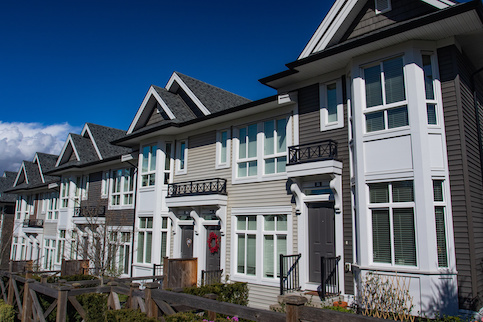If you’re considering investing in real estate, you’ll find a dizzying array of possibilities. From buying a house or a condominium to shares of a real estate investment trust (REIT), it can seem impossible to choose. However, you can identify the ideal type of investment for your situation when you understand each option, your investment approach, and your budget.
Whether you want to become a real estate tycoon or diversify your portfolio, understanding the basics can help you choose among asset types and maximize returns. Here’s how to invest in real estate.
Find A Mortgage Today and Lock In Your Rate!
Get matched with a lender that will work for your financial situation.
What Is Real Estate Investing?
Real estate investing means purchasing land and property for financial gain. Because many types of real estate are available for investment, strategies vary widely among investors. For example, you can purchase, manage, rent out and sell real estate for profit.
In addition, you can purchase partial ownership of properties, like buying stock in a company. Likewise, you can opt for a passive or active approach to real estate investing, meaning you can set it and forget it or review your assets daily.
Investors put money into real estate to diversify their portfolios. This essential investment tactic spreads your risk and provides exposure to more asset types. In addition, real estate is a lucrative business. For example, purchasing a rental property can immediately provide a stream of monthly income.
See What You Qualify For
Home Purchase
Home Refinance
Tap Into Equity
Different Ways To Invest In Real Estate
Just as real estate in and of itself will diversify your portfolio, you can diversify your investments in real estate. Here are several ways to invest:
Flipping Houses
When you flip a house, you buy a home needing extensive repairs, fix it up and sell it for a higher price. Successful flippers can renovate houses quickly and put them back on the market to make a financial gain.
It takes time and energy to flip a house, and the longer you take, the more it’ll suck away at your profits. So, it’s essential to limit your initial investment with a modest price and keep renovation costs low. However, sometimes large problems take extra time and money to fix and surprises can crop up.
Rental Properties
A rental property is a building you own and lease out to tenants, who pay monthly rent to use your property. For example, you could buy a commercial building and rent it out to a business owner. On the other hand, a residential property would mean renting it out to an individual or family.
This strategy is profitable even if you have a mortgage on the property because you can charge enough rent to cover your monthly payment and have some money left over for a small profit. For example, if the mortgage for your property costs $1,500 monthly, you can charge $1,700 for rent and pocket the remaining $200 after making your payment. Then, once you pay off the mortgage, most of the rental income is then profit. Remember, you’ll still need to pay taxes and insurance.
Along with taxes and insurance, you’ll need to factor in maintenance and monthly management of the property. Will you handle this, or will you hire a management company? If you’re handy, you could save a lot of money by doing repairs yourself.
All of these will factor into your overall cash flow. So, some number-crunching is necessary to find the ideal rental property for your situation. Remember, your property can appreciate as well as generate rental income. Therefore, rental properties can become even more profitable if you sell them in the future.
Real Estate Investment Trusts (REITs)
A real estate investment trust (REIT) allows you to invest in real estate without owning or managing property. Instead, you invest money in a set of real estate assets like you’d purchase shares of stock.
Here’s how it works: investment companies sell shares of stocks, issue bonds and use the revenue to purchase multiple properties. Then, they lease the individual units for monthly rent payments.
The primary benefit of REITs is they have a legal obligation to share at least 90% of their profits with their shareholders. These payouts, known as dividends, come in the form of cash and additional shares in the fund. As a result, your long-term gains can grow exponentially.
However, REITs can contain numerous asset types. For example, your portfolio may include malls, office buildings, apartment buildings and mortgages. These can generate substantial gains over time. Remember, you don’t have complete control over the real estate assets in a REIT, so investment decisions are up to the REIT management company.
Real Estate Investment Groups (REIGs)
Real estate investment groups (REIGs) buy or build properties and then sell off property parts to real estate investors. For example, a REIG will buy an apartment building and allow investors to buy units within it.
REIGs handle locating tenants, property maintenance and the other responsibilities of owning a rental property, giving you a hands-off approach to investing in real estate. However, REIGs charge administration fees for their services, so you’ll lose out on some of the profits. In addition, you rely on the REIG members for their expertise and honesty, with little legal recourse if the investments fall apart.
Real Estate Crowdfunding
Crowdfunding uses social media to attract investors and pool money to invest in real estate. This way, investing is open to everyone, not just the usual real estate investors.
Participating in crowdfunding is an inexpensive way to get into real estate and allows you to pick an investment that appeals to you. For example, you might choose a REIT whose shares are too expensive for an average investor to afford. However, crowdfunding means you can join tens or hundreds of other investors in purchasing a high-value REIT share.
Real Estate Limited Partnerships (RELPs)
A type of REIG, a real estate limited partnership (RELP) is a group of investors who pool their money to purchase property and then develop or lease it. You’d chip in a specific amount and receive equity in the properties the RELP purchases. For example, if five investors put in $200,000 to purchase $1 million in real estate, each person would have an equal 20% share of the assets.
RELPs implement a partnership agreement naming general and limited partners. General partners take care of the property management of the investment, while limited partners have equity shares but don’t participate in day-to-day decisions.
Take the first step toward buying a house.
Get approved to see what you qualify for.
Pros And Cons Of Investing In Real Estate
Real estate brings certain benefits and disadvantages, as does any asset type. Here’s what to remember when investing in real estate:
Pros
Real estate offers the following perks:
- Increased cash flow. Rental properties and REITs can provide a steady stream of cash, which can become a passive income source during your career and retirement.
- Tax benefits. Specifically, you can write off property management costs, repair expenses and depreciation losses. Plus, you can defer taxes through 1031 exchanges and diversify your tax situation through capital gains taxes. To reap these tax advantages and more, it’s best to consult a tax attorney.
- More equity. Owning property means owning the spending power of the real estate as well. For example, say you have $500,000 worth of rental properties. You have $150,000 left to pay on the mortgages for these properties. As a result, you have $350,000 of equity you can leverage for cash or loans for further investments.
- Diversification. While investing in stocks and bonds is an excellent idea, real estate is a profitable asset class to add to your portfolio. In other words, real estate investments can provide income while other assets suffer during market downturns.
Cons
Real estate also comes with these pitfalls:
- The long-term nature of the investment. For example, rental properties create a monthly income stream, meaning it can take years to earn significant income.
- Extra time and effort becoming necessary. For instance, flipping homes takes time because you must purchase, repair and resell each property. As a result, real estate can be a slow, arduous path to profits.
- Potential need for more money upfront. Real estate is usually expensive, often taking hundreds of thousands of dollars to start. Therefore, commercial and residential real estate can be inaccessible to the average investor not interested in REITs or crowdfunding.
- Low liquidity. Some real estate assets, such as REITs, are liquid. However, a physical property is not a liquid asset because you can’t turn it into cash quickly if necessary. Unlike a stock, which you can sell at any time, a piece of real estate takes time, money and work to sell.
How To Start Investing In Real Estate
Here’s how you can begin investing in real estate.
1. Assess Your Financial Situation
First, it’s best to evaluate your financial situation. Specifically, having substantial savings and little debt can help you invest in REIT shares or provide a hefty down payment. Plus, a good credit score helps you qualify for reasonable loan rates, minimizing costs when purchasing properties.
In addition, it’s a good idea to build a financial cushion before investing to address unexpected expenses or income disruptions. For example, you could have a two-month gap without a tenant or a roof needing repair.
Strengthening your financial standing also helps you get a mortgage preapproval. This can help you understand how much you’ll qualify for in terms of a mortgage for a rental property.
2. Choose Your Investment Strategy
Second, you’ll choose a real estate investing strategy. This process means evaluating your strengths and weaknesses. For example, if you have excellent credit and are a home renovation expert, you could flip homes or purchase rental properties while keeping expenses low. On the other hand, if you have substantial cash but little market knowledge, a REIT with a successful track record could provide excellent gains.
In addition, consider how you’ll diversify your investments. For example, you can invest in various real estate types, such as technology, banking and retail. On the other hand, if you prefer rental properties, you might only be able to afford a single building at first. Then, as you continue to purchase more properties, you will become more diversified.
Lastly, it’s crucial to understand the risks. A rushed or uninformed investment can result in the loss of your entire investment. Therefore, it’s best to do your homework and spread your money among multiple assets.
3. Work With Real Estate Professionals
Next, look for the right real estate professionals, such as a real estate agent, broker or REALTOR®, to help you invest. A real estate professional can help you find properties that meet your goals and dig up off-book opportunities that aren’t listed.
If you have a group of properties, you may also need an individual or a company to manage the properties, a real estate attorney to handle transactions, and an accountant to take care of the financial side of your business.
Furthermore, a real estate agent can help connect you with other professionals with experience in your area. Working with seasoned investors can save you thousands of dollars and countless headaches.
4. Research The Current Market
Researching real estate market trends, including your local market, can help you secure the best deals. Whether you hire a real estate agent for their knowledge or fly solo, informed decisions are the most profitable.
For example, while real estate prices are increasing on average, San Francisco has experienced a 7.6% drop since last year, according to the January 2023 S&P CoreLogic Case-Shiller index. As a result, it’s vital to understand your regional market dynamics before sinking money into real estate.
5. Close On The Deal
The final step is closing, meaning you pay the closing costs, sign paperwork and receive ownership of the real estate. Generally, you’ll pay for an appraisal, inspection, loan origination and insurance to close. In addition, you usually sign a document legally binding you to repay the mortgage.
On average, buyers pay an average of 3% to 6% of the purchase price in closing costs. In other words, if you’re applying for a $200,000 mortgage for rental property, you’ll pay $6,000 – $12,000 in closing costs. Working that number into your budget before you get to the closing table is crucial.
The Bottom Line
Investing in real estate can take the form of rentals, house flips, REITs and more. Each type comes with its own risks and rewards and necessitates research to be profitable. In addition, it’s essential to solidify your financial situation before committing to a property.
See What You Qualify For
You can get a real, customizable mortgage solution based on your unique financial situation.

Ashley Kilroy
Ashley Kilroy is an experienced financial writer who writes for solo entrepreneurs as well as for Fortune 500 companies. She is a finance graduate of the University of Cincinnati. When Ashley isn’t helping people understand their finances, you may find her cage-diving with great whites or on safari in South Africa.












